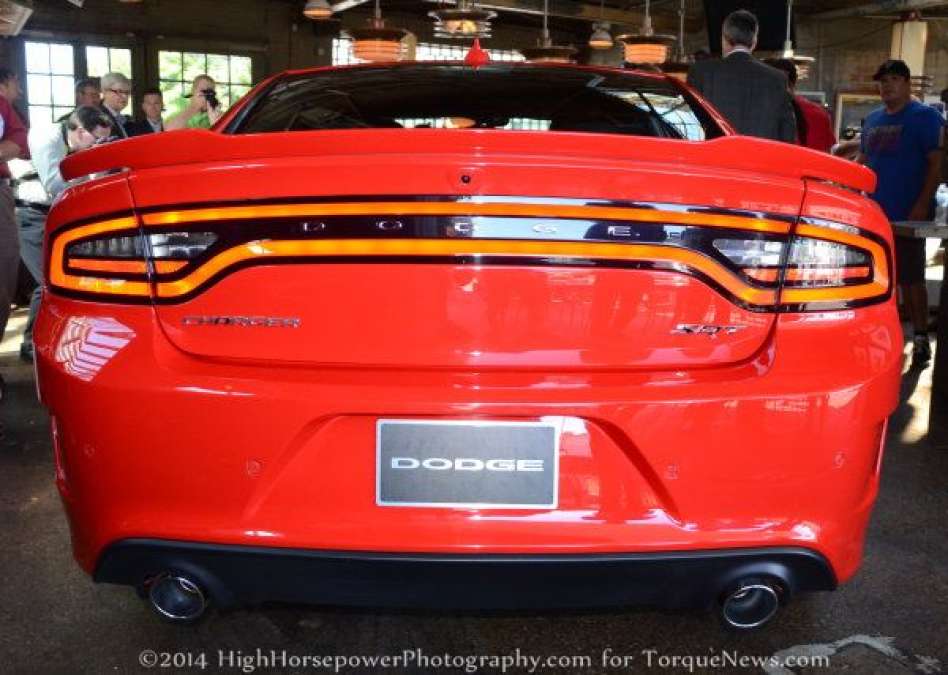TorqueNews Exclusive: Hellcat Charger Runs 10.7, 2.9s 0-60 with DRs (Updated)
Yesterday morning, I attended a small gathering at the Chrysler Headquarters in Auburn Hills Michigan for an in-depth look at the new 6.2L Hellcat Hemi that powers variants of the 2015 Dodge Charger and 2015 Dodge Challenger. We were walked through a piece by piece run-down of what makes the supercharged Hemi so awesome and towards the end of the informative slide show, we saw a video of the Hellcat Charger blasting down the quarter mile with drag radial tires. We don’t get to see the whole run, but we can see the timing screen that clearly displays the elapsed time for the 707 horsepower sedan of 10.7 seconds.
The Quickest Sedan in the World
When the Chrysler Group announced earlier this year that the 2015 Dodge Challenger SRT Hellcat could run a stock-tire time of 11.2 and a drag radial time of 10.8 – both of which were certified by the NHRA – it shook up the performance world. Those numbers make the Challenger quicker than any stock American muscle car ever (not counting the non-street legal race models like the COPO Camaro, the Mustang Cobra Jet or the Challenger Drag Pak), but when the 2015 Charger SRT Hellcat was introduced before the 2014 Woodward Dream Cruise, Dodge brand CEO Tim Kuniskis announced that the bigger, heavier 4-door Charger was actually faster in the quarter mile.
When equipped with the stock tires, the Charger SRT Hellcat is officially capable of running an elapsed time of 11 seconds flat, making the sedan two tenths of a second quicker than the Challenger with the same drivetrain (Hellcat Hemi, 8-speed automatic transmission). However, Kuniskis didn’t announce the drag radial tire numbers for the Charger so we didn’t know how much quicker the Hellcat sedan was with good tires – until yesterday.
A 4,500lb Sedan in the 10s
During the Hellcat Hemi presentation at the Chrysler HQ, SRT drivetrain engineer Chris Cowland walked us through a collection of slides that told us everything that we could want to know about the new supercharged V8. Among those slides was one that showed the Charger SRT Hellcat with a set of non-production rear wheels and drag radial tires testing on the quarter mile.
Hellcat Galleries:
Live images of the 2015 Dodge Charger SRT Hellcat debut
The 2015 Dodge Challenger SRT Hellcat in TorRed
The 2015 Dodge Challenger SRT Hellcat in Sublime
On the right side of that slide was the SRT timing screen from inside the car, showing the performance numbers for that particular quarter mile run. This included a 0-60 time of 2.9 seconds, a 0-100 time of 7.2 seconds, an 8th mile time of 6.8 seconds and a quarter mile time of 10.7 seconds. This screen also showed us an 8th mile trap speed of 96 miles per hour and a quarter mile speed of 120 miles per hour – which Chris Cowland quickly stated was slower than usual. He went on to explain that on most strong runs, the Hellcat Charger is able to hit around 126 miles per hour in the quarter mile…in a 4,500+ pound sedan. You can watch the video from the presentation below.
Potential for Even Better Times
Considering that the 2015 Dodge Charger SRT Hellcat shown in the video below hits 60 in just 2.9 seconds and 100 takes just 7.2 seconds, I would guess that this Charger got away from the line about as quickly as is possible. However, when Chris Cowland pointed out that the trap speed is usually 6-7 miles per hour faster, it brings into question that 10.7 quarter mile elapsed time. If you listen to the audio in the video below, you can clearly hear the Charger let off towards the top end of the track and that is likely why it “only” trapped 120 miles per hour. Had the driver stayed in the throttle for the whole run to hit the normal trap speed of 127 miles per hour, the Charger would have almost surely turned a faster quarter mile time – even if only a tenth or two quicker.
In other words, the 2015 Dodge Charger SRT Hellcat is clearly able to run a 10.7 quarter mile time, but it seems that there is some room left for improvement with that elapsed time so private owners with some seat time in their 707hp Charger could cut their stock quarter mile time (with good tires) into the 10.5 range…and that is crazy quick for anything, let alone a full sized sedan.
Update: I had a chance to speak with a representative of the Chrysler Group who had some unfortunate news on the video shown below. First off, the Performance Pages graphic shown on above does not correlate to the video showing the Hellcat Charger launching. The intent was to show the Charger launching during their intensive performance testing and the Performance Pages screen was added alongside the video to show what a resulting screen from a quarter mile pass might look like. They wanted to show the Performance Pages screen with some impressive numbers for those who haven’t dealt with the SRT Apps.
Chrysler stands firm on the fact that the Hellcat Charger is capable of 11 second runs per NHRA certification guidelines and the Performance Pages screen has numbers that are not an accurate representation of what the Hellcat Charger can do under those certification guidelines.
Also, the Charger shown launching was fitted with full race slicks and not drag radials – but that doesn’t change the fact that the Performance Pages screen showing a 2.9 second 0-60 and the 10.7 quarter mile does not pertain to this Charger drag strip pass.



